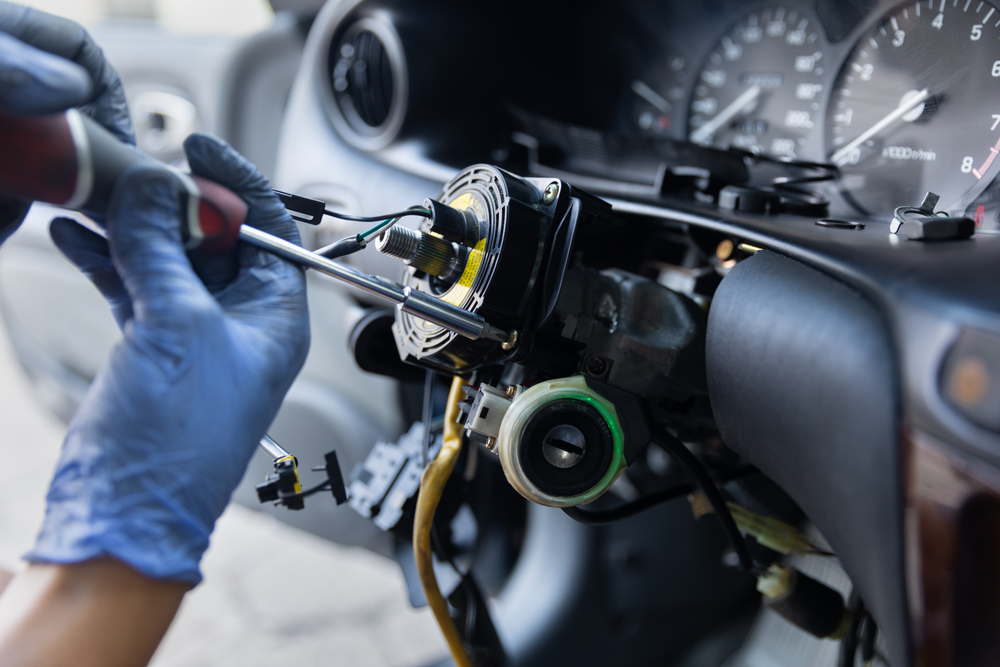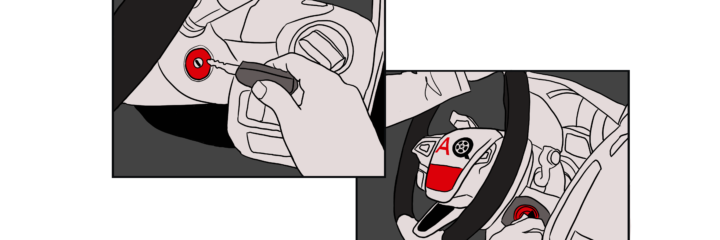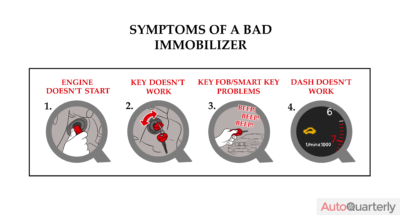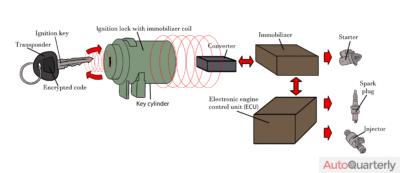An Immobilizer is supposed to prevent people from stealing your car. When they malfunction, though, they can’t discriminate between you and a thief. That can lead to hours of frustration while your car refuses to start.
In this guide, we’ll go over what an immobilizer is, what it’s supposed to do, and how to find out if it has gone bad. We’ll also give you a quick look at the replacement process. First things first, though, let’s look at the symptoms of a bad immobilizer.
Symptoms of a Bad Immobilizer
There are four areas affected when an immobilizer goes bad. Please note that you may not experience all of these symptoms; every car is different. These are simply the most common issues that can occur.
Engine Won’t Start
This is the most common problem when you have an immobilizer issue. At its core, the immobilizer is meant to prevent a thief from making off with your ride. It does that by preventing the engine from working.
It’s important to understand the difference between the immobilizer malfunctioning and a low battery. A low battery will turn the engine slowly. You should be able to jump a dead battery and be on your way. If the immobilizer is bad, though, the engine either won’t crank at all, or it will crank at the normal speed and just not fire.
Key Fob/Smart Key Problems
Immobilizers are often tied directly into the locks and alarms. That means if one goes bad, your locks and alarms will behave funky. Your key fob might not work at all, or the alarm will go off if you press unlock, or other unusual things may happen.
This can be especially annoying if you have a car that doesn’t have external locks. Your key may not be able to unlock your car doors, and you will have to call a professional to get your doors open again.
The only good news here is that most locksmiths who specialize in automotive systems are also more than capable of disabling the immobilizer altogether, so you can still drive around after.
Key Won’t Work
Some cars are equipped with an immobilizer that prevents the ignition cylinder from turning at all. That means you can’t turn the key, and chances are the steering wheel will be locked in place as well.
If you experience this, don’t try to force it. You risk breaking the key in the cylinder or damaging the internals of the ignition cylinder. Ignition cylinders are much more expensive to replace than immobilizers.
Dash Doesn’t Work
The final thing you’ll notice is that the dash won’t work. A lot of newer cars have fully digital dashes that are tied directly to the ignition system, so when you get locked out due to a bad safety device, the dash won’t even try to work.
Some cars have a dashboard light just for the immobilizer. It often looks like a key, but you should check your manual to find out for sure. If that lights up and doesn’t go off after a few moments, it means your key isn’t working. That’s often a sign that your immobilizer is having an issue.
How the Immobilizer Works
Immobilizers have a few components to them that all work together.
- A key containing a microchip
- A sensor that reads the microchip
- A program on the car’s computer that interprets the reading
When people talk about the immobilizer failing, they usually are referring to the sensor that reads the key. On cars that use a traditional keyed ignition, this sensor is part of your steering column. On cars with push-button start, it’s usually just a small box installed somewhere behind the dash.
However, a problem with any of those components will cause the same symptoms. Your car doesn’t know which part isn’t working; it just knows that the system isn’t giving it the all-clear signal. This video does a great job showing all the parts and going in-depth on the individual parts.
Key Problems
Modern cars use “smart keys” or similar devices that interact with the car to let the car know that you are the rightful owner. Sometimes they are RFID tags that communicate with your car wirelessly. Other times, they are simple electronic circuits built into the body of the key.
Regardless of how your key works on a technical level, it has some form of unique identifier installed on it. Sometimes those stop working, and you’ll need to go to a licensed locksmith or your dealer to have a new key crafted and synched.
Ignition Cylinder Problems
As we mentioned above, the most common immobilizer problems happen to the reader. Somewhere in the wiring under your dashboard is a small computer that reads the information contained in the key and checks to make sure it’s the right information.
The reader technology has changed a lot over the last 20 years, so it’s difficult to say exactly how your particular car works. It’s especially hard because some manufacturers keep it a secret so that would-be hackers have a tougher time stealing cars.
Often, if you have this issue, you will be replacing an entire module. A key can be reprogrammed, but the reader can be difficult to interact with because of the secrecy and security.
PCM Issues
The PCM, or powertrain control module, is the car’s “brain.” Every device in the car gets its instructions from the PCM, and the PCM waits until it gets the right signal from the key to start giving instructions. PCMs can fail, though. It is a lot more rare than other issues.
Why Do They Fail?
Many parts, especially parts that utilize small electronics, simply wear out over time. An immobilizer is no different. They are designed to last a long time, though, so usually, a failure will be linked to some kind of physical damage. The most common damage happens when wires get pinched or short out.
Modern smart keys also have a battery in them. If that battery dies, it can cause the key to fail altogether. You can get a new battery at most locksmiths or general stores. Many dealerships will also replace the battery for a nominal fee.
How to Test an Immobilizer
Unfortunately, there is no universal way to test an immobilizer. Some methods include using very complicated equipment, while others simply require dismantling half of your dashboard.
It’s probably best to start by eliminating other issues. You can test your key by following the quick guide here or going to a locksmith. You can check the health of your PCM by using one of the OBD2 scanning tools we recommend. If the battery is charged, the key works, and the PCM is healthy, then you probably have a bad immobilizer.
Fixing a Bad Immobilizer

You basically have three options if you suspect your immobilizer has gone bad. You can replace it yourself, which is a great option if you have space to work and basic hand tools. You can also just bypass the immobilizer, which isn’t the best option if you are worried about the security of your car, but it is the cheapest. Finally, you can pay a mechanic to fix it.
Replace It Yourself
Most of the cost involved with replacing an immobilizer is related to labor. That means that you can save a lot of money by replacing it yourself if you have the time.
Unfortunately, we can’t give you a guide for your car. As we mentioned above, there are many variations, and more are being created every day. However, we can give you some tips and tricks to make the process easier.
You Will Need
- A service manual
- Trim removal tools
- Screwdrivers
- Wrenches
- Wire cutters
- Your keys
Tips and Tricks
- Keep parts separate and labeled. Dashboards have a lot of connections, and re-assembly goes much faster if you aren’t guessing.
- Be careful prying on interior trim pieces. If you can, work the pry tools around the seams until you find one of the locking tabs, then apply gentle pressure to the tab itself.
- Disconnect the negative battery terminal before you start. If nothing else, it will prevent the alarm from going off while your face is near the horn.
- Some immobilizers will require you to “drill out” a screw. Start with a small drill bit and drill a shallow hole into the head of the screw, then use a bigger bit to remove enough material that you can slide the part off without taking out the screw. Use vice grips to remove the rest of the screw.
- When replacing the immobilizer, make sure that you follow the instructions from the manufacturer. Sometimes you need to use a complicated series of button presses and key turning combos to get the computer to accept the new device.
Bypass the Immobilizer
As an alternative to replacing the immobilizer, you may be able to bypass it entirely. This probably isn’t a good option if you are worried about thieves. However, on an older car that just needs to work, it can be a very cheap option.
You will have to Google your car’s make and model to find out exactly how to bypass the security system. Some cars do well with an aftermarket device like a Mobokey. Some cars can be forced into run conditions using a process outlined here.
Often, though, you’ll simply be removing the old, broken immobilizer and looking up which two wires to crimp together so that the computer thinks everything is ok.
Take Your Car to a Mechanic
If you don’t have the time or space to replace an immobilizer yourself, most mechanics would be happy to perform the task for you. You can expect to pay around $300-400. The part itself is often fairly cheap, but it can take a long time to expose the immobilizer and replace it.
You can always ask the mechanic to simply disable the immobilizer rather than pay to replace it. It will leave you with fewer security features on your car, but if money is a concern, it’s often much cheaper.
Don’t Let Bad Electronics Bring You to a Halt
Modern cars are full of electronics, which is both a blessing and a curse. On the one hand, it’s incredibly good for one’s peace of mind to know that your car can’t just be started with any old key. On the other hand, when they fail, it can be incredibly frustrating. We hope this article alleviates some frustration and helps you get back on the road as soon as possible.




